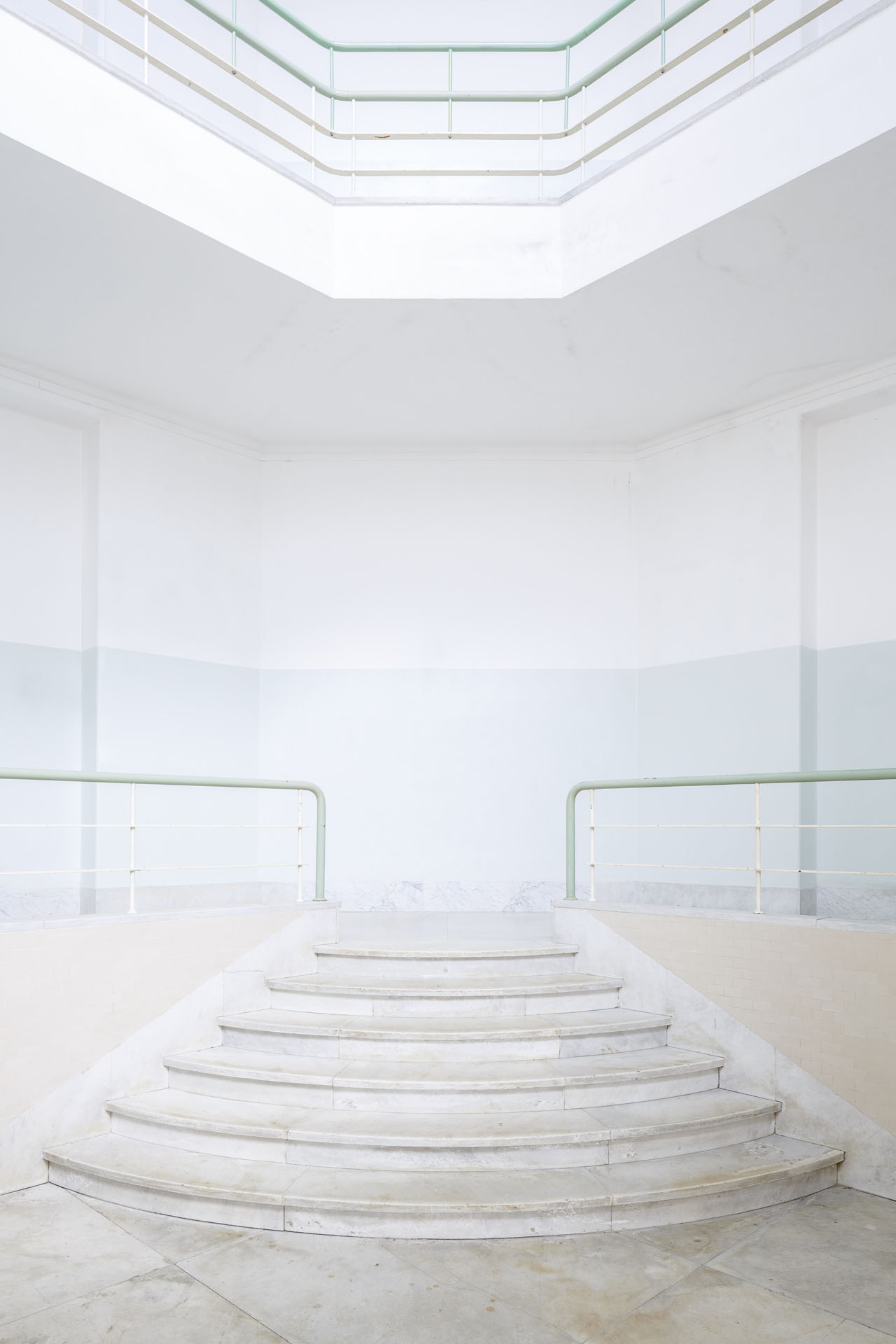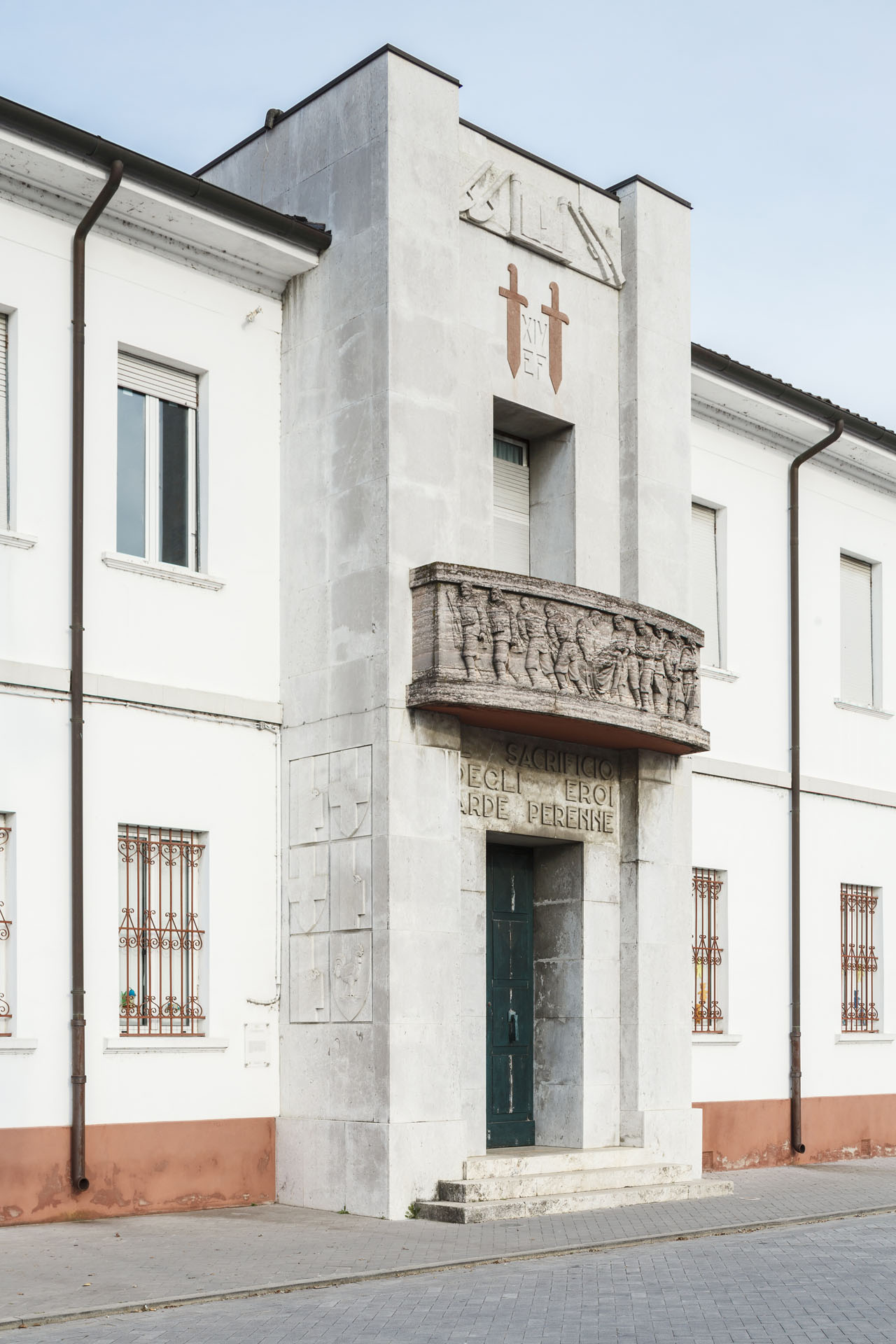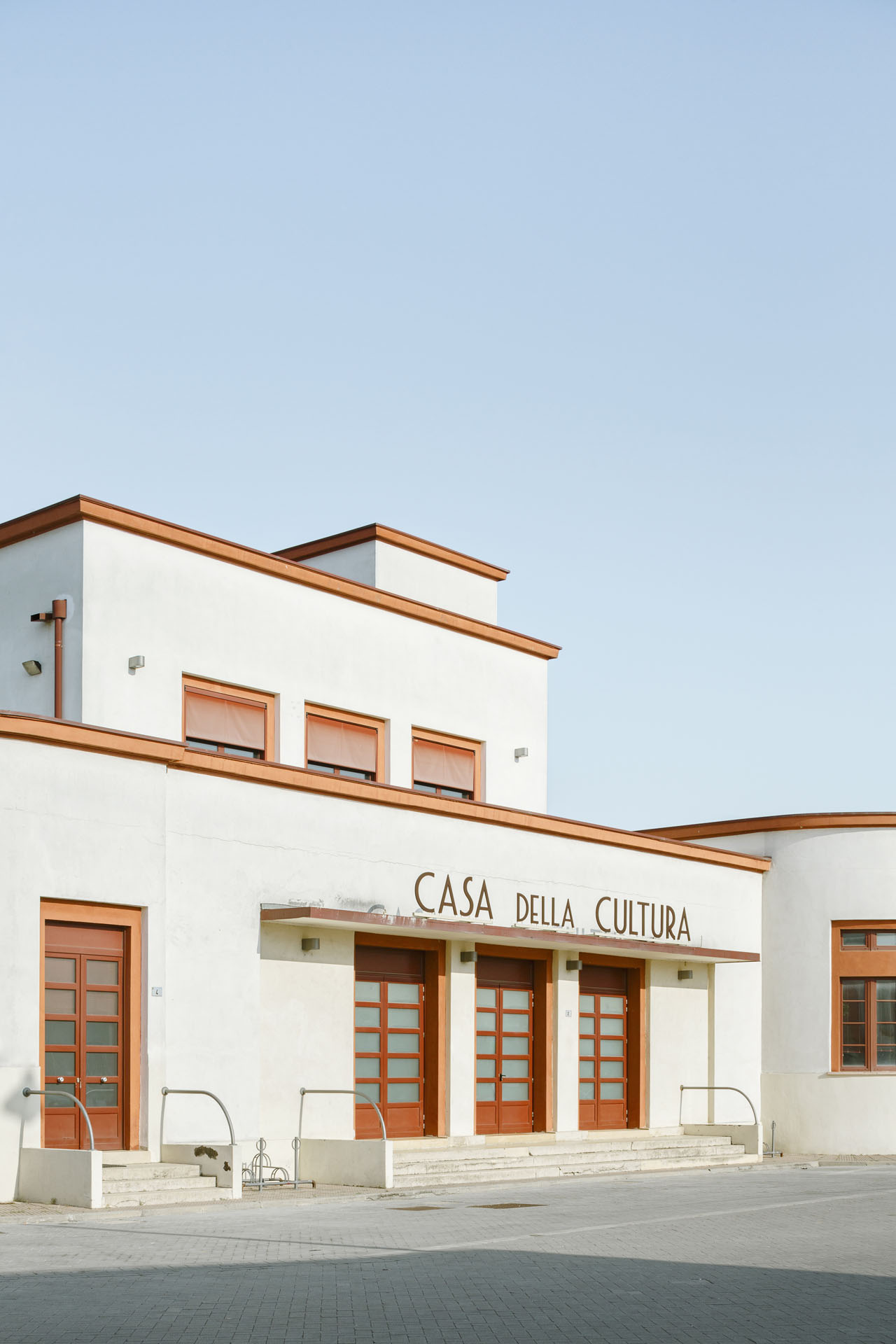Everything
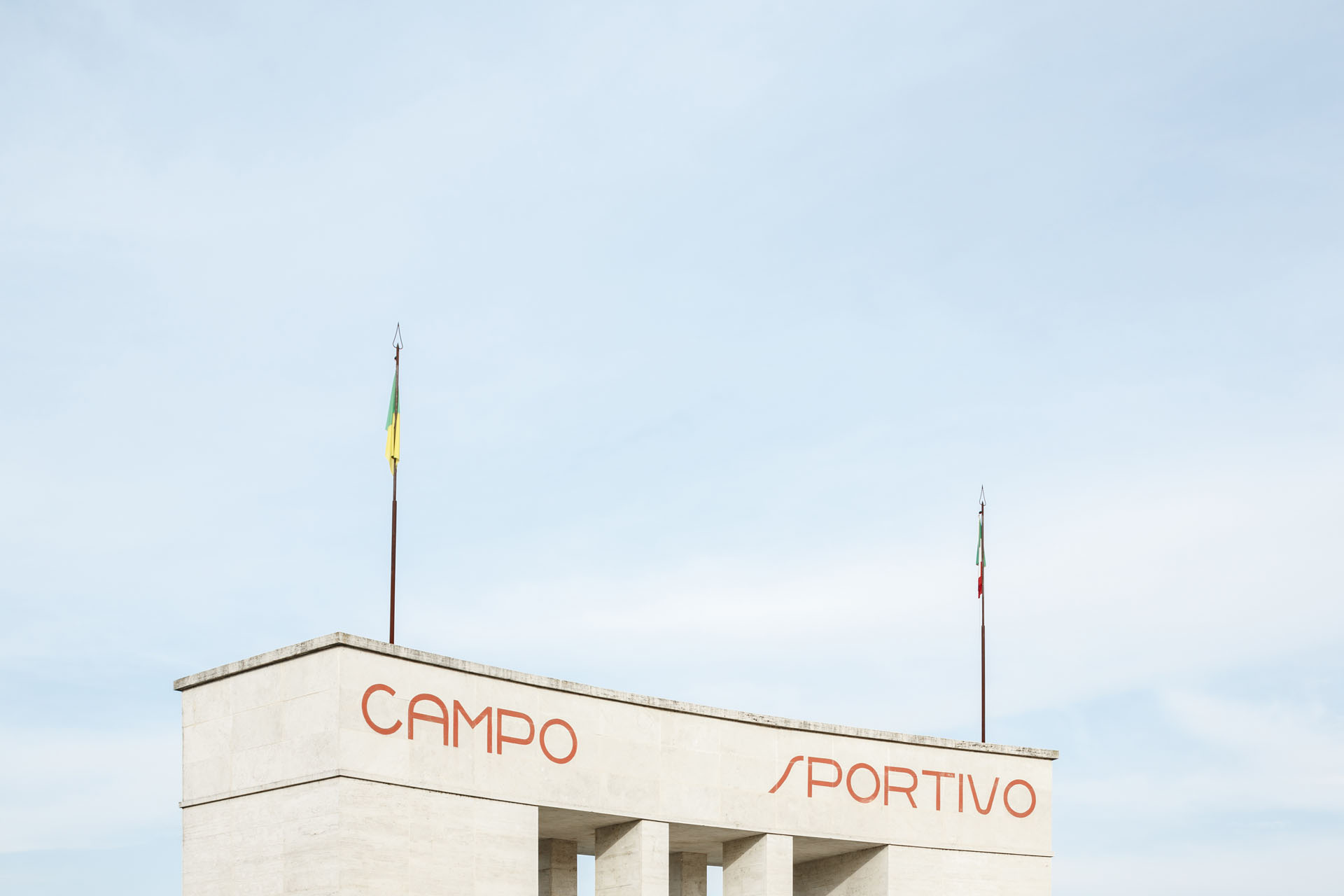
In the middle of the countryside, a monumental entrance rises from a series of rectangular shapes, undoubtedly with rationalist influences. Above, in “littorio” characters, reads the inscription: sports field. The clear and sharp lines of the travertine rock makes a short circuit against the triumphal blue of the sky. It is the welcome of Tresigallo, a city built in the 1930s on a plain that extends from Ferrara to the sea, and is here where the river is intertwined. More than just a foundation — as befits these urban examples of the Fascist age — the space has transformed itself into a re-foundation. And while in the past there was nothing prestigious about Tresigallo, its importance has been elevated through history.
Nine hundred inhabitants occupied the great beaches of the village in an ambitious scheme to transform the space with commercial buildings, factories and warehouses — as ordered by Edmondo Rossoni. The former socialist, journalist, melomaniac and hierarch of the regime, ascended to the position of minister of agriculture. Yet soon after, in 1939 and on the eve of World War II, politician Benito Mussolini removed him from office and he retired to private life.
The ideal of Tresigallo was the result of an innovative trade unionism: a class collaboration between workers and entrepreneurs to improve the conditions of a population otherwise forced to emigrate. And in the new perimeter of the masterplan, with avant-garde construction solutions, the city grew under Rossoni’s guidance to host 12,000 residents.
Mussolini’s Italian Youth House of the Littorio — the youth movement of the National Fascist Party — was one of the main tenants of the area, with its commercial activities including the Albergo Italia, a school, hospital, and the Casa del Ricamo, which at the time welcomed single mothers. The agriculture and industrial zone produced sugars and mechanical goods.
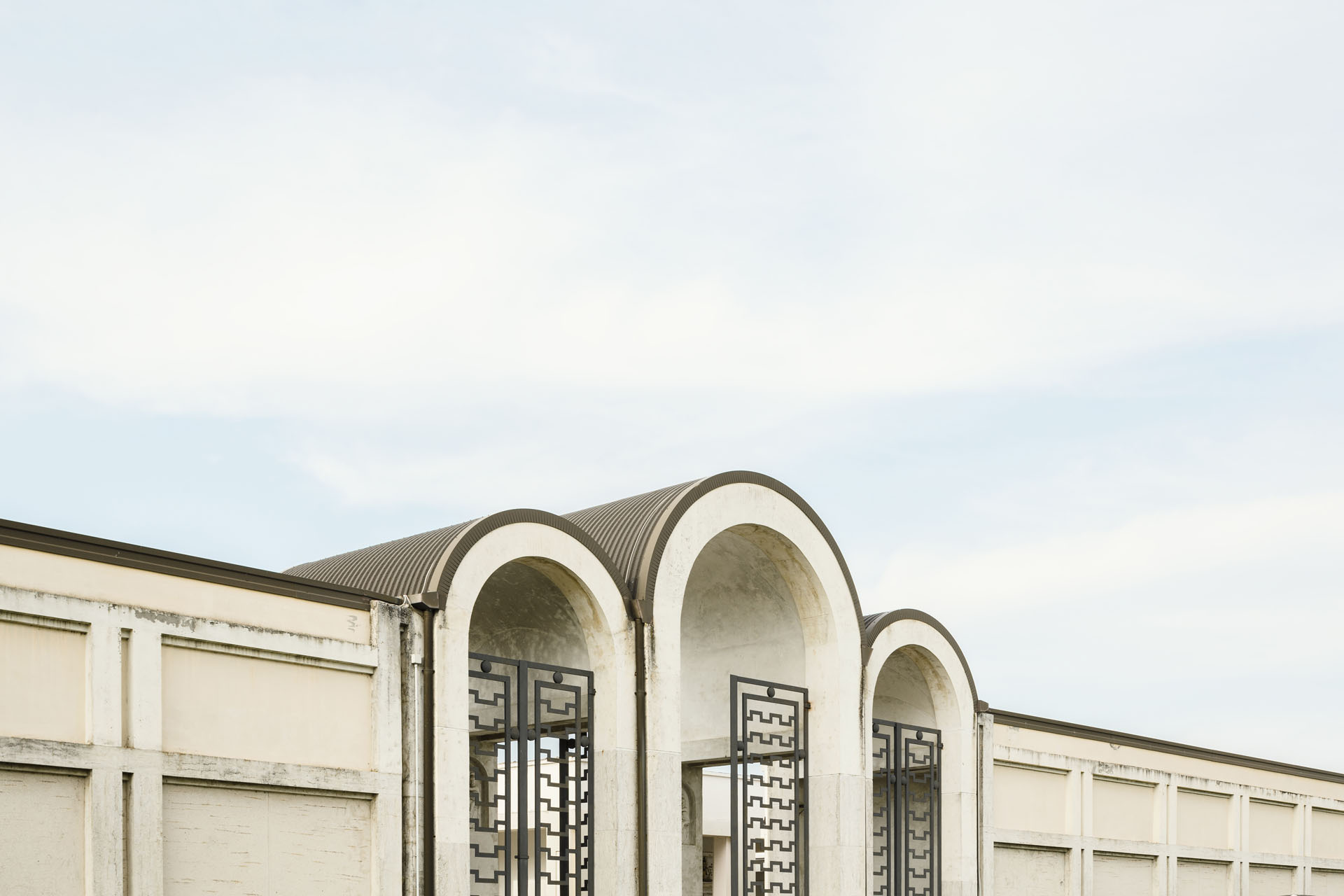
Today, there is overall fascination with all aspects of the city, including its facades, with buildings in in white, yellow, ochre, green and blue. But the history of Tresigallo also deals with the embarrassment of Fascist memory. Its fault? An architectural product made according to a dictatorship. It was here, until recently at least, that the economic crisis of the territory affected its survival. Currently, from an original 9000 residents in its early expansion, population has fallen to 4000, with more than 1400 of those aged 40 or older. Many buildings have begun to show signs of deterioration and the ravages of history, with important funds needed for restorations.
The local administration went looking for alternative ideas, embracing the fact that the past, however cumbersome, could be a resource. First Tresigallo adopted the title of the City of the 20th Century. Its design was modern for its time, with long and straight streets connecting mausoleums and squares, and architecture that was far more elegant than certain anonymous houses of the ’60s. From there, Tresigallo became the Metaphysical City. The porches and fountain in Piazza della Repubblica — a masterpiece by Giorgio de Chirico — was an example of architecture with a strong presence, more than capable of filling the silent spaces.
Now, tourism councillor Stefano Giglioli has a dream: “That Tresigallo can intercept architecture enthusiasts and expand the tourist niche. We are on the direct path leading to the sea and millions of people pass by each year. It would be enough to intercept a fraction to revive the city.” There are some initial signs, even if it was as simple as Swedish university students coming to study this urban space, that visitor numbers would multiply every week. An association of young volunteers is also involved in the promotion project, coined the Marble Towers. “We started with communication,” explains Francesco Emiliani, who has the energy of an enthusiastic 30-year-old. “A renovated tourism website, autumn days with visits dedicated to architects and designers. The goal is for Tresigallo to obtain the orange flag for quality tourism.”
Entering the city from the neighbouring village of Formignana, the first “metaphysical” building was once the public baths. A change of initials and a requalification and it is now it is a space for exhibitions. Another beautiful structure is the city library, occupying the great premises of the House of Culture; from its terrace the gaze stretches the length of the main boulevard, Viale Roma. On the left is the Theatre of the 900, built by the those who worked on construction of the city. On feast days the 234-strong team worked freely for social enterprise. Today, Adriano Boni is his presidency involves the population in prose and music performances. “Sixty-five years ago, I was just eight, I came here to sell drinks and sweets. Now I promote the child-friendly opera.”
On the other side of the road is the imposing former Casa del Fascio, now known as the Carabinieri barracks. Roman travertine renders the entire façade of the building and its 12-metre tower with litoceramic covering imitating the brick, is a dominant feature of the city. It was closed for many years, and the town has long waited for it to be sold by a private company.

“And to think that we would have already budgeted the money for the transformation project in the centre for health services,” laments the commissioner Giglioli. While awaiting the longed-for passage, it is advisable to admire the rainfall of the cement.
In Tresigallo every story carries to another one. To sew them together is a former teacher who has discovered in itself a biographical vocation of the place. Mauro Merlanti is a mine of anecdotes. “Here the events of the buildings are intertwined with those of the people,” he says. “This is why they fascinate me.”
Let’s take the hospital, a five-storey building surrounded by seven hectares of parkland. The renowned “heliotherapeutic colony” built by the engineer Carlo Frighi, gave substance to the sketches that Edmond Rossoni sent continuously from Rome, but is now restricted to five rooms, where local doctors take samples and some visits. The structure is huge. The doors open and between the emptiness and the abandonment that is the action of time, we discover the chapel of the nuns of the Sacred Heart of Jesus, and a spectacular wooden confessional . But it is on the top floor that there is an incredible story, told of those who have passed through here. During the war years, while other people welcomed the displaced fleeing from Ferrara and the cities, so-called “Tripoli” were sheltered in the attic. They are the sons of Italian immigrants in Libya who, separated from their families, have been repatriated, using the same route on which migrants venture today. There were 13,000 people, mostly children, in the Romagna colonies. In Tresigallo there are 120. Adrift, they had to take refuge in the attic of the hospital waiting for the end of the conflict. Now we walk through those same spaces, divided by the immense beams of support.
In 1997, when the hospital was already assisting fewer patients, another department was inaugurated by then health minister Rosy Bindi, which never entered into operation. One and a half million euros have been allocated for emergency interventions to the structures. However, restoration of the entire complex would cost in the vicinity of €8 million.
The recent administrations of Tresigallo, despite the economic cost involved, are still committed to preserving its heritage. This is the case of the restoration of the “Calefo” agricultural consortium. Ferrociaria pioneer Giorgio Baroni, for example, designed and developed a state-of-the-art cover for hemp stores: just three centimetres of reinforced concrete, which remains perfect some 80 years later. The Domus Tua building, which looks at the portal of the sports eld, with its three-storey tower, recalls the architecture of overseas Italian colonies. Here, in the ’50s and ’60s, stars like Nilla Pizzi and Rita Pavone would perform in the vast ballroom. It’s now a private home waiting for an alternative use, perhaps as a hotel.
For Edmondo Rossoni there was a scenographic “fifth” element between the industrial area — that of work, that of memory: the cemetery. It is embellished with a fountain where bronze gazelles are watered. But it is under one of the porticoes that the history of the village of Tresigallo has its own vital witness. In the narrow premises of a grass-roots organisation, Renzo Poletti preserves photographs and documents on the life of the city. The former typographer has recently turned 90 but boasts a memory of absolute lucidity.
“In a country lost and without roads to a certain masons, carpenters, glaziers, marble workers, appeared from Bologna, Mantua, Modena … a great one movement. At my age, the miracle seemed to grow out of nothing into a city. Then, however, we felt that we were at the centre of the world. At most, the youngsters could go cycling to Ferarara, “to kiss the Old Man’s ass”, as we then said. Instead the landscape was changing before our eyes. That week, Rossoni dressed in white and with a pipe, came to inaugurate a new neighbourhood. The labourers, from the fields, had the opportunity in time to become workers and find work in the new manufacturers. What I liked most were the people from so many parts of Italy. And then they remained. So, to instil sap in the imaginary city.”
And today? “We are waiting to reunite the country with Formignana and its 3500 inhabitants,” explains councillor Giglioli. “It is a marriage of interest to optimise services and cut costs. Maybe in favour of some new restoration.”
In the next months, Tresigallo will also be able to count on a revival of image thanks to cinema. Italian film director Pupi Avati will use some glimpses of the village for a new film. “I will shoot it for Rai Cinema [Italian film television channel],”, anticipates the Bolognese director. A useful author spot for meta-historical architecture in search of promotion. The path to the end still leads here, to Square Forlanini, at the entrance to the sports field. On the opposite side is the important elementary school. Beyond the green façade, we enter a vast atrium. A full light from the entrance marks the path
on the original floor with “Palladian” decorations: there is the double staircase that leads to the classrooms. Noises, laughter, voices chasing each other during recreation. The children approach the classrooms and look curiously at those who came to discover the city, beautiful but now with too many empty spaces. They have a different approach: they simply live there. Now. And if for Tresigallo there will be a future of rebirth, that we hope to see.
